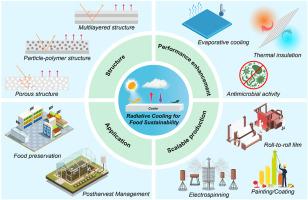Multifunctional radiative cooling materials: A transformative pathway for zero-energy food preservation and postharvest management
IF 15.4
1区 农林科学
Q1 FOOD SCIENCE & TECHNOLOGY
引用次数: 0
Abstract
Background
Global food security is facing mounting pressure from postharvest losses, energy-intensive refrigeration, and carbon emissions associated with conventional cold chains. Radiative cooling (RC) offers a passive, zero-energy solution for thermal management, but its ideal cooling performance and single-functionality cannot meet the requirements for food applications. Nevertheless, recent breakthroughs in RC materials have dramatically enhanced both cooling capacity and multifunctionality. These advances establish a critical connection between fundamental thermodynamics and scalable applications, positioning RC as a transformative technology for food preservation and postharvest management.
Scope and approach
This review introduced multifunctional RC strategies tailored for food systems, bridging fundamental principles with real-world implementation challenges. We critically evaluate: (1) Mechanisms governing radiative heat transfer and development of RC materials; (2) Hybrid systems integrating evaporative cooling, thermal insulation, and antimicrobial functions, as well as scale manufacturing technologies of RC materials; (3) Applications across food preservation and postharvest management (fruits, vegetables, grains, dairy, cold chain logistics) as well as food production (greenhouse cladding, soil mulches); (4) Critical challenges and future directions for sustainable thermal management in the food sector.
Key findings and conclusions
The functional hybrid strategy of RC materials not only overcomes cooling power limits, but also imparts antibacterial properties, making them suitable for food preservation and postharvest management. Spectral tunability in RC materials enables efficient utilization of solar light by crops, thereby enhancing food production. Large-scale manufacturing enables the practical application of these technologies in the food sector. These findings highlight how multifunctional RC materials emerge as viable, zero-energy solutions for sustainable food systems, reducing postharvest losses while enhancing food production.

多功能辐射冷却材料:零能耗食品保存和采后管理的变革途径
全球粮食安全正面临着来自采后损失、能源密集型制冷以及与传统冷链相关的碳排放的越来越大的压力。辐射冷却(RC)为热管理提供了一种被动、零能耗的解决方案,但其理想的冷却性能和单一功能无法满足食品应用的要求。然而,最近在RC材料方面的突破极大地增强了冷却能力和多功能。这些进步建立了基础热力学和可扩展应用之间的关键联系,将RC定位为食品保存和采后管理的变革性技术。本综述介绍了为粮食系统量身定制的多功能RC策略,将基本原则与现实世界的实施挑战联系起来。我们批判性地评估:(1)控制辐射传热和RC材料发展的机制;(2)集蒸发冷却、保温隔热和抗菌功能于一体的混合系统,以及RC材料的规模化制造技术;(3)食品保鲜和采后管理(水果、蔬菜、谷物、乳制品、冷链物流)以及食品生产(温室覆盖、土壤覆盖)的应用;(4)食品行业可持续热管理的关键挑战和未来方向。RC材料的功能性杂交策略不仅克服了冷却功率的限制,而且赋予了抗菌性能,使其适用于食品保鲜和采后管理。RC材料的光谱可调性使作物能够有效地利用太阳光,从而提高粮食产量。大规模生产使这些技术在食品部门的实际应用成为可能。这些发现突出了多功能RC材料如何成为可持续粮食系统可行的零能耗解决方案,减少采后损失,同时提高粮食产量。
本文章由计算机程序翻译,如有差异,请以英文原文为准。
求助全文
约1分钟内获得全文
求助全文
来源期刊

Trends in Food Science & Technology
工程技术-食品科技
CiteScore
32.50
自引率
2.60%
发文量
322
审稿时长
37 days
期刊介绍:
Trends in Food Science & Technology is a prestigious international journal that specializes in peer-reviewed articles covering the latest advancements in technology, food science, and human nutrition. It serves as a bridge between specialized primary journals and general trade magazines, providing readable and scientifically rigorous reviews and commentaries on current research developments and their potential applications in the food industry.
Unlike traditional journals, Trends in Food Science & Technology does not publish original research papers. Instead, it focuses on critical and comprehensive reviews to offer valuable insights for professionals in the field. By bringing together cutting-edge research and industry applications, this journal plays a vital role in disseminating knowledge and facilitating advancements in the food science and technology sector.
 求助内容:
求助内容: 应助结果提醒方式:
应助结果提醒方式:


